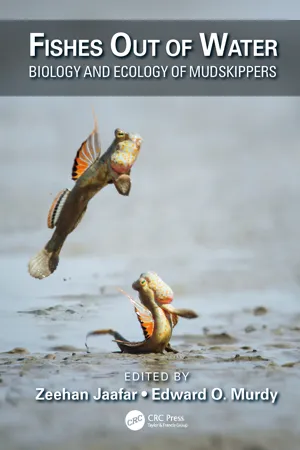
Fishes Out of Water
Biology and Ecology of Mudskippers
- 390 pages
- English
- ePUB (mobile friendly)
- Available on iOS & Android
Fishes Out of Water
Biology and Ecology of Mudskippers
About this book
Mudskippers are amphibious fishes native to the Indo-West Pacific and tropical western Africa. Unlike most fishes, mudskippers emerse to forage, find mates, and defend territories. Adaptations to their morphology, physiology and behavior enable mudskippers to accommodate both aquatic and terrestrial habitats. For these traits, mudskippers have long captured the fascination of scientists, naturalists, and fish hobbyists. Some mudskipper taxa (e.g. Periophthalmodon spp., Periophthalmus spp., Boleophthalmus spp.) are readily observed on mudflats and mangrove forests during the ebb tide. Correspondingly, these conspicuous and widespread taxa are relatively well-studied. The autecology and basic biology for the remaing taxa (e.g. Apocryptodon spp. and Oxuderces spp.) are still poorly understood.
Fishes Out of Water: Biology and Ecology of Mudskippers is the first comprehensive book to synthesize published scientific information and observation on these fishes. Two dozen subject experts present thorough overviews in fifteen distinct chapters. Contents span mudskipper anatomy, distribution, systematics, physiology, ecology, and conservation. Unique adaptations to terrestriality are discussed within the context of each chapter foci.
This authoritative reference equips the reader with the basic foundation to understand mudskipper biology and ecology, while providing a framework in which emerging data are discussed. The book will be of interest to a broad range of students, researchers, and professionals in ichthyology, evolution, ecology, animal behavior, and comparative physiology.
Frequently asked questions
- Essential is ideal for learners and professionals who enjoy exploring a wide range of subjects. Access the Essential Library with 800,000+ trusted titles and best-sellers across business, personal growth, and the humanities. Includes unlimited reading time and Standard Read Aloud voice.
- Complete: Perfect for advanced learners and researchers needing full, unrestricted access. Unlock 1.4M+ books across hundreds of subjects, including academic and specialized titles. The Complete Plan also includes advanced features like Premium Read Aloud and Research Assistant.
Please note we cannot support devices running on iOS 13 and Android 7 or earlier. Learn more about using the app.
Information
CHAPTER 1
Taxonomy and Systematics Review
CONTENTS
1.1 INTRODUCTION
1.2 HISTORICAL ACCOUNTS OF OXUDERCINE GOBIES

| Figure 1.1 | One of the first, if not the first, mudskipper illustration from the 1690s. (From holthuis l.B. and pietsch t.W. Les planches inédites de poissons et autres animaux marins de l’Indo-Ouest Pacifique d’Isaac Johannes Lamotius, publications scientifiques du Muséum, Muséum national d’histoire naturelle, paris, 2006. courtesy of national Museum of natural history (paris), directorate of libraries and documentation.) |
1.3 HIGHER LEVEL RELATIONSHIPS
Table of contents
- Cover
- Half Title
- Series Page
- Title Page
- Copyright Page
- Dedication
- Contents
- Foreword
- Preface
- Contributors
- Chapter 1 Taxonomy and Systematics Review
- Chapter 2 The Natural Distribution of Mudskippers
- Chapter 3 Early Development of Mudskippers
- Chapter 4 Age and Growth
- Chapter 5 Respiratory and Circulatory Adaptations
- Chapter 6 Structure and Function of Sensory Organs
- Chapter 7 Nitrogen Metabolism and Nitrogenous Waste Excretion
- Chapter 8 Aquatic and Terrestrial Locomotion
- Chapter 9 Review of Reproductive Strategies
- Chapter 10 Feeding Behavior: A Review
- Chapter 11 Territoriality and Courtship Behavior
- Chapter 12 Emergent Patterns in Spatio-Temporal Ecology
- Chapter 13 Care and Management in Captivity
- Chapter 14 Taxa and Habitat Conservation
- Chapter 15 Challenges and Future Research: An Australian Perspective
- Index